
W hat is a blog? And what do bloggers do? You're about to learn everything you need to know!
Simply put, a blog is a type of website that publishes articles (called “blog posts”) on topics. (The word “blog” is actually short for “web log,” originally starting as a kind of online diary and since branching out into all sorts of niches.) A blogger owns and/or writes blog posts for a blog. The main goals of most bloggers are to increase their readership and earn money.
But there are still some questions you may be curious about, like:
- What does a blogger do all day?
- What skills do you need to be a blogger?
- How do bloggers get paid?
- And can you actually get started?
Don’t worry. In this article, we’ll answer all your questions about what a blogger does and how you can become a successful blogger.
So, let’s get started!
In This Guide:
Key Takeaways on What are Blogs and Bloggers
- A blog is a type of website that publishes articles on various topics with the goal of increasing readership and earning money.
- A blogger creates content, promotes the blog, interacts with readers, does affiliate marketing and email marketing, and may sell products and services.
- Bloggers can monetize their blogs through affiliate marketing, selling digital products like ebooks or courses, displaying ads, and other methods.
- Blogging allows you to share knowledge, connect with an audience, and potentially earn a living from anywhere with internet access.
- Key tasks for bloggers include writing posts, doing keyword research, finding images, email marketing, social media promotion, and website maintenance.
- To grow a successful blog, you need to consistently create valuable content, engage with your audience, make good use of SEO strategies for bloggers, and explore monetization strategies for how to make money online.
- Determining your blog’s niche, goals, and target audience is crucial for building a loyal readership and income stream.
But now if you’re ready to learn more – let’s dive deeper into what a blog is.
What is a Blog?
A blog is a type of website where a writer or a group of writers share their views on a particular subject. It can be for personal use or for business purposes.
Blogs are regularly updated with content, and the posts are typically displayed in reverse chronological order, with the newest web pages appearing at the top of the page.
Here’s an example of a blog that fits that criteria:
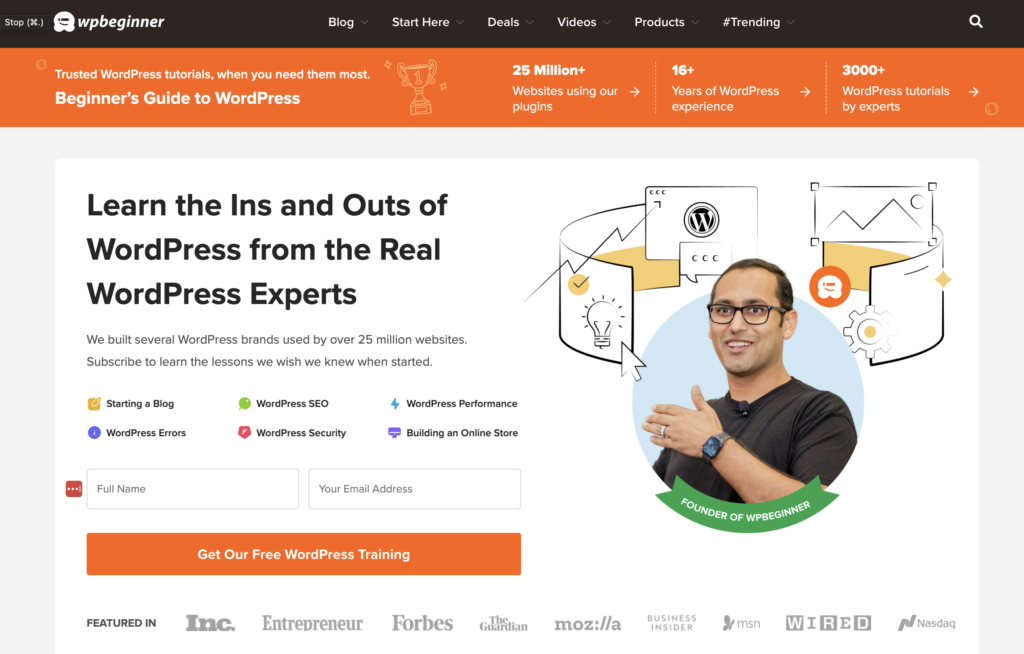
WPBeginner is a blog that regularly produces content meant to educate readers about WordPress.
And the blog post you’re reading right now is from Blog Tyrant, a blog all about blogging.
You’ll find all kinds of blogs on the web on every topic imaginable. And the writing style is often more conversational and informal than other types of websites – but not always!
Many of the details depend on a blog’s goal. There are many personal blogs out there, similar to online journals. Just in case you’re interested, I’ve included a quick history of blogs below.
But nowadays, many blogs are run by businesses hoping to attract new customers with their blog posts via SEO or social shares.
For more examples, check out this post on different types of blogs.
What’s the Difference Between a Blog and a Website?
One key difference between a blog and a website is that content is published regularly on a blog. The site may have a few static pages, like an about me and a contact page, but the main focus is the blog.
As I mentioned, the site you’re on right now, Blog Tyrant, is a perfect example of a blog!
On the other hand, a website is usually more static and doesn’t change the content as often. A regular website comprises pages like the homepage, about us page, services page, and more. It can even be a single page if that’s all needed. Historically – once a website is built and published, it remains there, mostly untouched for long periods of time.
A great example is a site like OptinMonster. The main page is a website dedicated to the OptinMonster lead generation software, and it doesn’t change very often. Then there’s also a separate OptinMonster blog that’s updated more often with new blog posts.
Are you ready to start your blog today?
Check out the special deal below to get 60% off Bluehost hosting which comes with a free domain name, free SSL certificate, 1-click WordPress installation, and more!
Exclusive offer for BlogTyrant readers
We have partnered up with Bluehost to get 60% off for our readers! You also get to register a FREE domain for a year which normally costs around $14.99 per year.
Claim this Exclusive Bluehost offerNow that you have an idea of what a blog is, let’s go over what bloggers do…
What Does a Blogger Do?
What you do as a blogger depends on your goals. If you want to create a blog for fun or to use it as an online diary, then you really just need to do one thing:
Write.
But, if you want to make money from your blog and turn it into a part-time or full-time career, there are other tasks you need to do. Some of these tasks include:
- Affiliate marketing
- Email marketing
- Social media marketing
- Selling a product or service
A blogger is someone who’s also responsible for various administrative tasks, like monitoring website analytics, keeping the site updated, responding to comments, and much more.
This is not a complete list, but let’s review some of the most important aspects of a blogger’s job.
1. Create Blog Content
The primary job of a blogger is to write content in the form of blog posts.
The primary job of a blogger is to write content in the form of blog posts.
Blog posts are meant to provide valuable information to people in a way that’s free and easy to read. It’s the first step to building trust with readers so that you can turn them into customers in the future.
For example, if you have a food blog and write blog posts about your favorite recipes, your readers will find value in that free content. Then, in the future, those readers will be more likely to buy your cookbook.
What you write about on your blog is up to you. There are blogs on the internet for almost any subject imaginable, like travel, health & wellness, finance, gardening, religion, video games, etc.
But, to attract a loyal audience, it’s best to stick to one specific type of blog subject, also known as a blog niche.
Once you select a blog name and decide what to write about, you should publish blog posts regularly to keep your site fresh.
To determine how often you should publish new blog content, check out our guide on blogging frequency.
But it all starts with that first blog post. And the sooner you get started the better!
So now, let’s get to the actual writing part.
There are a number of tasks that go into writing your blog content. You’ve got to:
- Brainstorm topics you want to write about
- Research the topic online and look at competitors’ posts
- Take notes and draft an outline
- Write the blog post
- Add images for visual engagement
- Optimize your post for SEO
As you can see, writing content isn’t just about putting words on a page.
If you’ve never written a blog post before, don’t worry. Many bloggers are self-taught and they learn how to write as they go.
If you want to speed up the learning process, you can read our guide on how to write a good blog post.
Writing is the foundation of a successful blog.
But, if you want to make money from your blog, you need to do more than just write…
2. Recommend Affiliate Products
Affiliate marketing is one of the most popular ways bloggers make money. It involves recommending products to readers within your content. Every time a reader uses your affiliate link to buy the product you promoted, you earn a commission for the sale.
Here’s an example from the travel blog Nomadic Matt. He wrote an article about the 5 best travel insurance companies:
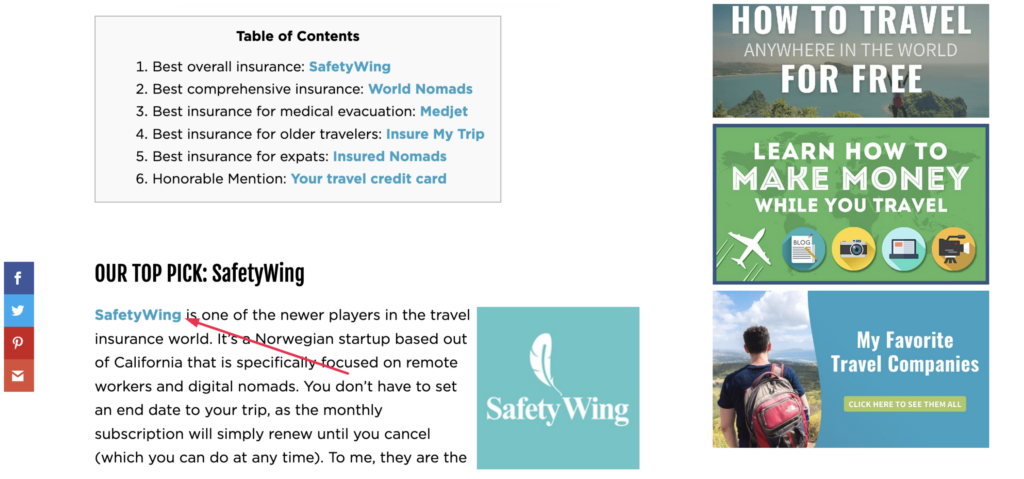
He has an affiliate link for each travel insurance company he recommends in the post. Whenever anyone clicks on a link and purchases travel insurance, he makes some money.
Affiliate marketing is an easy way to start making money blogging because you don’t have to create a product yourself. Plus, you can write one good product review, and that article can earn you money over and over again.
Just make sure that the affiliate products you’re promoting on your blog are ones that you truly use and believe in.
They should also be relevant to your audience. It wouldn’t make sense for a travel blogger to recommend kitchen appliances or car parts. Things like luggage, travel insurance, and hotels would be more relevant to your readers.
To get started with affiliate marketing, you can join an affiliate marketing network like ShareASale:
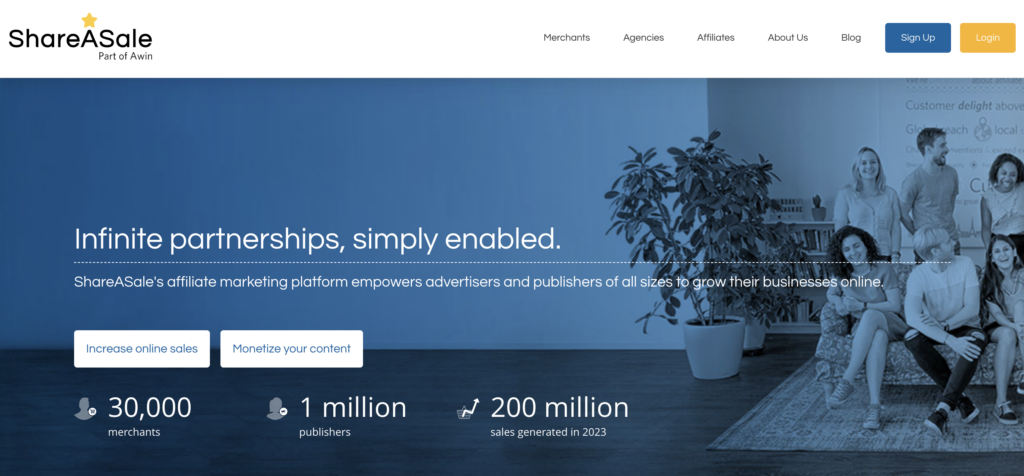
Simply sign up for free and search for products you want to recommend on your blog section.
Want to learn more about affiliate marketing? Read our guide on how to start affiliate marketing.
3. Email Marketing
Email marketing goes hand-in-hand with blogging. With email marketing, you can develop a more personal relationship with your readers through regular, direct communication.
Plus, any time you have a new blog post or product to promote, you can send the information right to your subscribers’ inboxes. This will help you drive more traffic to your blog and even generate sales.
Getting started with email marketing isn’t as difficult as it sounds. At Blog Tyrant, we have a complete guide on how to do email marketing.
You can also follow along with this tutorial to learn how to create an email newsletter.
What can be difficult, though, is convincing people to sign up for your email list.
That’s why we recommend using a tool like OptinMonster.
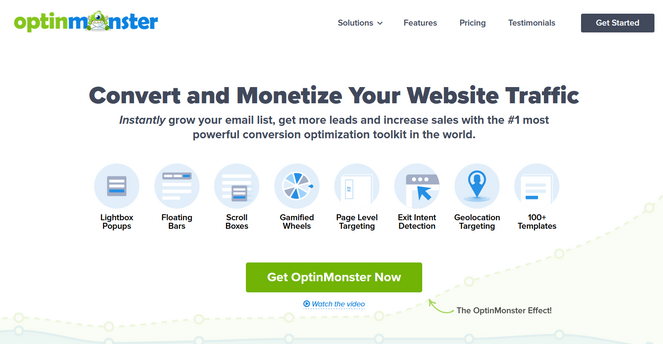
OptinMonster is an amazing lead-generation tool that makes it easy to turn website visitors into subscribers. You can quickly create beautiful email optin popups using the professionally designed templates and drag and drop builder.
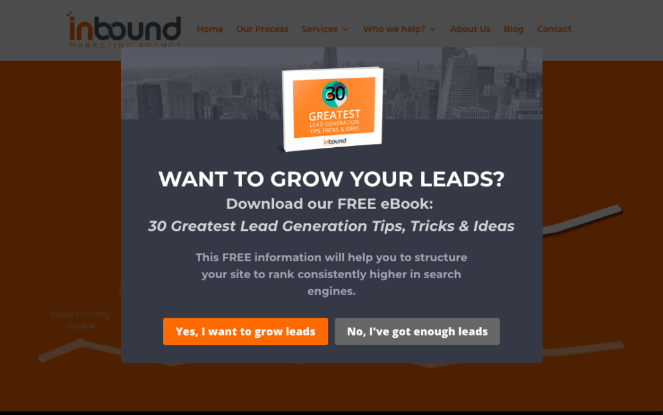
And you can automatically deliver a lead magnet, such as a free ebook, when someone signs up for your email list, like in the popup example above. Most people are more than willing to provide their email addresses if they’re going to get a free gift in return.
With OptinMonster, you can quickly grow your email list and start building long-lasting relationships with your readers.
Aside from building relationships with your existing readers, you also need to attract new visitors to your blog…
4. Self-Promotion
Self-promotion is another thing you’ll have to do as a blogger. After all, if you want new people to discover your blog and read your content, you have to promote it.
Don’t worry though; this doesn’t mean you have to buy ad space or create a big marketing campaign.
You can simply promote your content on social media.
Social media platforms like Facebook, Instagram, Twitter, and LinkedIn, are perfect for promoting your blog posts because they’re free and easy. Plus, most people are on social media these days, which means it won’t be hard to attract your target audience.
Here’s how the blog Pinch of Yum promotes their latest blog posts on Instagram:
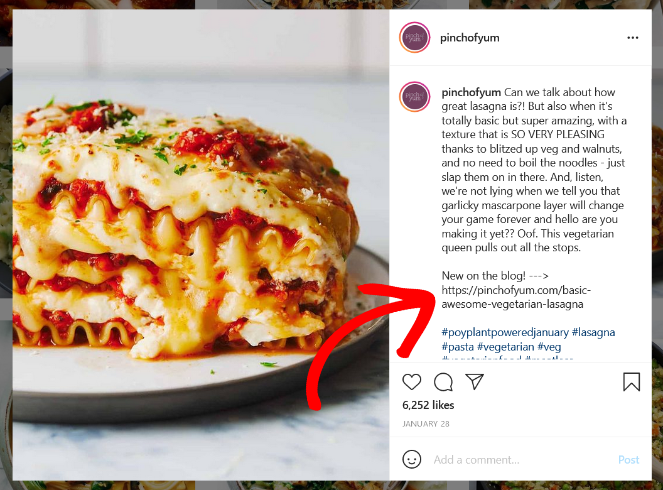
As you can see, they use an eye-catching image, an engaging caption, and relevant hashtags like #Lasagna, #Pasta, and #Vegetarian to promote their new blog post. The hashtags make it easy for people interested in recipes and cooking to discover this post via Instagram search.
They also add the URL of the blog post to the caption in order to drive traffic to their site.
By consistently promoting your content on social media, you’ll be able to get the word out and make it easier to find your blog.
Check out our ultimate guide to social media for more tips.
Promoting your blog on social media is easier when you have a large following that will engage with your posts and share them for you.
So, to grow your social media following, try embedding social media feeds on your blog. This will introduce your social profiles to website visitors and encourage them to follow.
You can easily do this with a plugin like Smash Balloon.
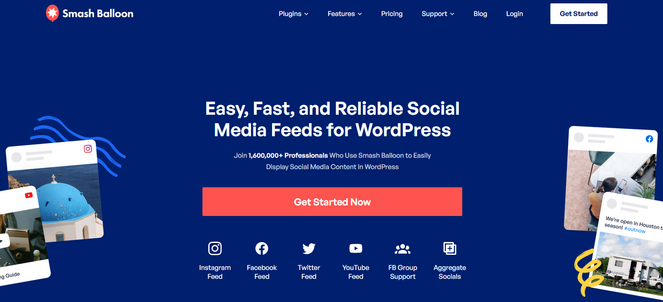
Smash Balloon is the best social media feeds plugin for WordPress. It’s super easy to use; simply connect your social media account, and in less than a minute, you’ll have a beautiful feed on your site.

You can choose from different layouts, decide which posts you want to display or hide, design the feed to match your brand, and more.
There are also lite versions of the plugins that you can try out for free.
5. Sell Products
Many successful bloggers scale their businesses by selling their own products. So, if you want to boost your blogging income, this is something you should learn how to do as well.
Most bloggers sell digital products rather than physical ones because they’re much easier to create. Plus, you only have to create a digital product once, and then you can sell it over and over again.
Now, you might be wondering—what kind of digital products can you sell as a blogger?
A digital product that’s both easy to create and sell is an ebook.
Here’s how the blog Succulents and Sunshine does it:
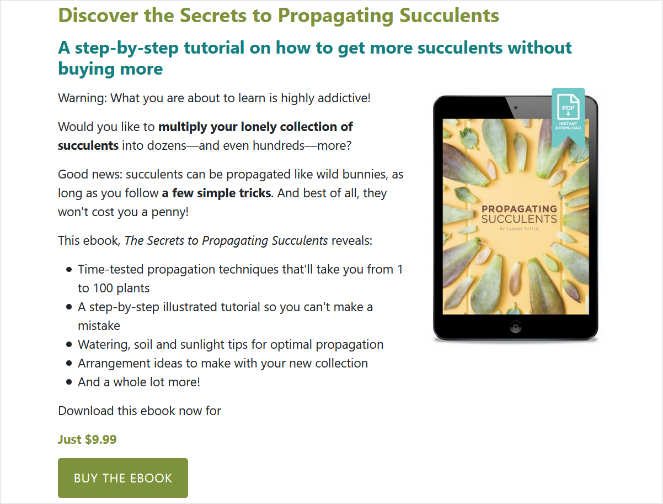
They created a PDF ebook on propagating succulents. Since their blog is usually about teaching their readers how to grow succulent plants, this ebook is filled with valuable and relevant information their audience would want to know.
Want to learn how to create your own ebook? Check out our guide on how to easily make an awesome ebook.
Another popular type of digital product you can sell is an online course. Online courses are an interactive way to teach your audience about a particular topic.
In the example below, blogger Melyssa Griffin created a course to teach people how to create profitable online courses.
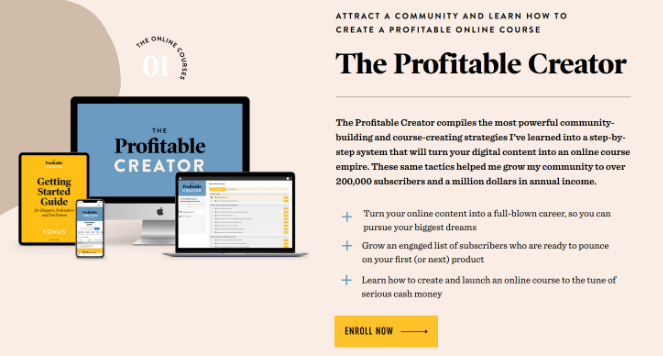
This course sells for a whopping $997! But, since Melyssa’s blog is about building a successful online business, her readers are willing to pay the price to learn her tips and tricks.
And don’t worry – you don’t need any teaching experience to create and sell an online course. All you need is some knowledge and experience in the subject you want to create your online course.
To build an online course, we recommend using MemberPress.
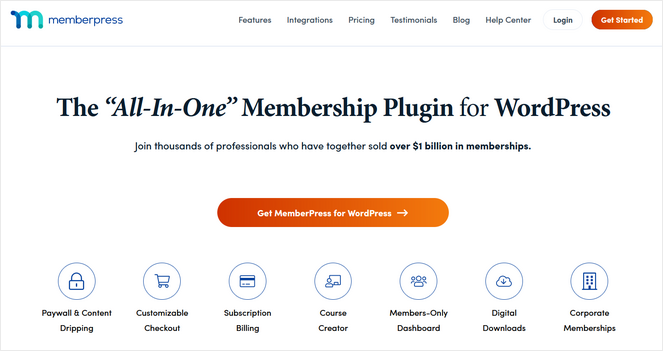
MemberPress is an all-in-one membership plugin for WordPress websites that includes a user-friendly online course builder. That means not only can you create and sell online courses with this tool, but you can also create a membership site. With a membership site, you can charge users a monthly subscription fee to view your blog posts.
Take a look at our guide on creating an online course with MemberPress for step-by-step instructions.
Now that we’ve gone through the main aspects of what a blogger does let’s go over some of the other tasks a blogger might have to do in a day…
Why Start a Blog?
Every blogger has their own motivation for blogging.
Some people look to network for personal or professional reasons, others want to provide themselves with a creative outlet, and some want to create and grow a business.
The Benefits of Blogging
Blogging has many benefits, whether you’re starting a personal one or adding one to a business website.
At a basic level, blogs give your website a better chance of attracting more visitors and readers. More visitors means more potential customers and revenue.
Your blog can:
- Showcase your skills and talents through an online portfolio to help you build a brand or find a new job.
- Help brands and businesses become thought leaders or authority figures on a topic or industry.
- Generate money through a side hustle.
- Raise awareness for a non-profit cause or mission you believe in and help influence public opinion on the topic.
Popular Blog Examples
Here are a few popular personal blogs that demonstrate what you can do with your blog.
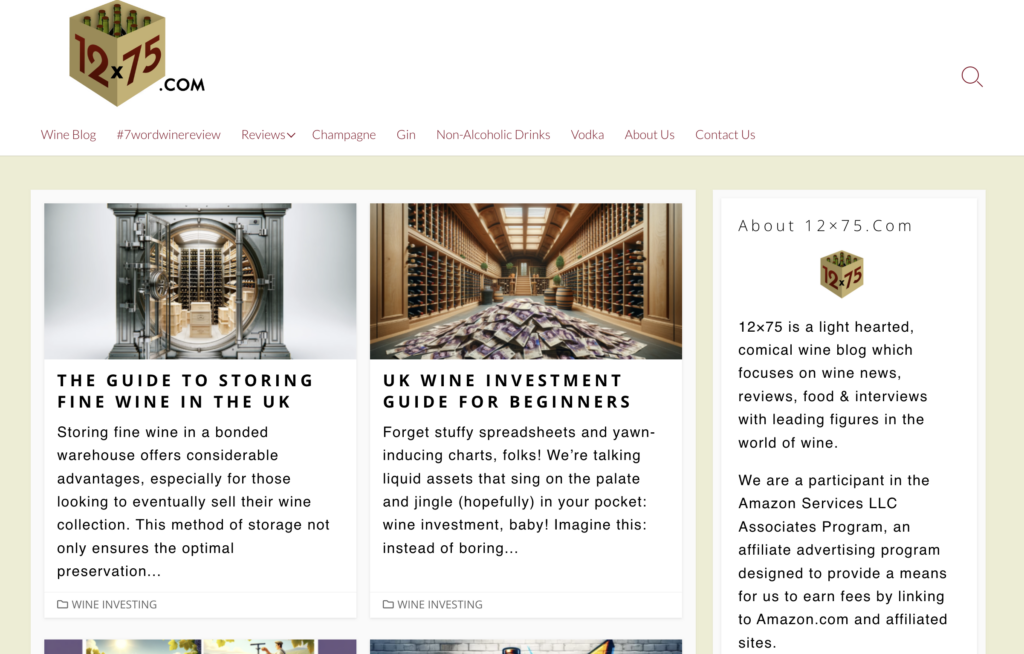
Vim started the 12×75 Wine Blog in 2011 because he found the market a bit stuffy and wanted to write about wine with more humor. Today, the blog has expanded to include a few more editors and writers. And it makes money with affiliate marketing.
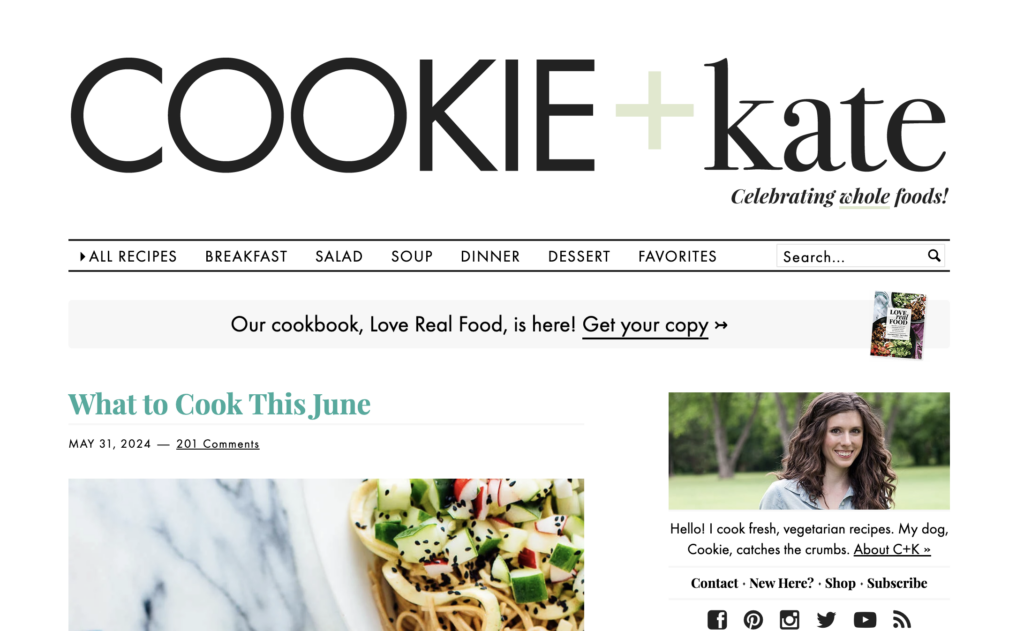
Cookie + Kate is a food blog that was started by a self-taught photographer and cook in 2010. She now works full-time on her blog. The blog makes money via ads, sponsors, and other monetization methods.
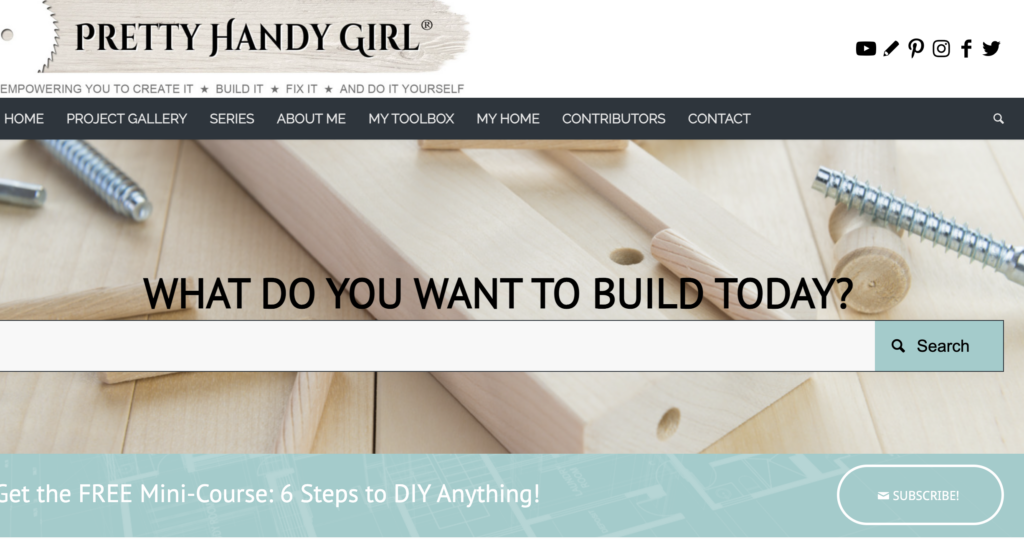
Pretty Handy Girl is a DIY blog by Brittany, a licensed general contractor and artist. She also monetizes her blog with Raptive ads and sponsored posts.

A Cup of Jo started as a hobby blog but became a full-time career for its founder, Joanna Goddard. Now, it’s a publication staffed by a whole team of writers.
What Makes a Successful Blog?
While many people think of bloggers as hobbyists who are just dabbling in writing online, as we’ve shown, some are wildly successful.
They might have started their blog as a side hustle, but they were able to grow it to the point they could quit their day jobs and build a successful business (find out more about what a blogger is and what they do here).
The key thing here is to think of what “success” means to you. How do you define blogging success? Is it earning six figures from your blog?
Or is it connecting with other like-minded people and creating a community? Is it creating an audience for your artistic creations? Or is it something else entirely?
Making Money with a Blog
There are a variety of ways blogs work to make money. The most common is through affiliate marketing. You recommend products and services to your readers and earn a commission when readers buy them through your link.
You can also make money by displaying ads; however, if your blog is new or has low traffic numbers, it’ll be hard to earn much money this way. For example, you could place some Google AdSense ads on your blog through text, images, videos (check out how to start a vlog if you’re curious), or other interactive ads.
The ads are targeted to your readers based on your blog content and audience traffic. You’ll earn money through these cost-per-click (CPC) ads every time a reader clicks an ad on your blog.
AdSense calculates how much to charge the advertiser for the click and then passes along a part of that money to you. The amount you receive per click varies based on several factors like traffic rates and keywords. For more ways you can monetize your blog, check out our post here.
- Blogging takes a lot of effort. You’ll need to put time and energy into research, blog writing, editing, rewriting, sourcing images, and promoting your posts. People who consider themselves writers will have an easier time, but there’s still a lot of work to do before and after they write.
- Optimize your blog. Your blog must have a search engine optimization (SEO) strategy to succeed (no matter your end goal). An SEO strategy will bring you more traffic because search engines love new content.
- Be committed to your blog’s purpose. Many people make money off their blogs, but it usually takes them years to reach that point. Reaching that point could take years of work and patience, so make sure you’re committed to it.
- Discover your inner geek. You’ll need a little technical knowledge to get your blog up and running. We recommend using WordPress for your blog and hosting it through a blogging web host like BlueHost. (Even the people at WordPress officially recommend BlueHost!) This will give your blog more storage and bandwidth, site security, and great tech support. You’ll also have the most flexibility when customizing your site with themes and more.
- Stick to a schedule. Not only will this help you get into the habit of writing fresh content for your blog (which search engines love), but it’ll also train your audience to expect the content from you. They’ll know when to return to your blog to read the latest post.
- Focus on one social media channel to promote your content at a time. Social media is an essential tool for any blogger. It’ll help you build your traffic and expand your audience. But with so many channels out there (Twitter, Pinterest, Facebook, Instagram, TikTok) and more being added every few months, you might think you need to be on all of them. That’s not always the case. You need to be on the one your audience is on. For example, if you’ve got a visual blog on design or photography, you should choose a visual channel like Pinterest or Instagram. And you can certainly repurpose a lot of your best content onto YouTube (you don’t need to choose between a blog or vlog – you can do both)! The key is to focus on growing on one platform at a time to build your loyal audience.
- Engage with your audience. It’s one thing to produce high-quality content on your blog and get lots of traffic. You’ve also got to engage with your readers. Answer their blog comments and interact with them on social media. Doing this will show your audience that there’s a real person behind the blog and that you care about what they have to say and learn more about your audience. It’ll help you craft even better posts in the future, which will resonate even more deeply with your audience. All of which will keep them coming back for more.
- Be authentic. Honest and authentic blog posts lend authenticity to your blog, which resonates with readers. Put yourself into your posts and share stories, events, and emotions that come from deep within you.
Checklist For How To Start a Blog and Grow It
The following checklist is an overview of all of the tasks you need to do as a blogger when launching a blog.
Of course, this list will vary depending on the blogger, but it will give you a general idea of what bloggers do in a typical day.
Let’s take a look:
- Brainstorm and search online for new blog topic ideas.
- Plan out your upcoming content using an editorial calendar.
- Write new blog posts 1-5 times per week, depending on your publishing frequency.
- Do keyword research so that your posts can rank higher in search results.
- Search for images to use on your blog or take your own photographs.
- Write and send your email newsletter, typically once per week. You can use an email marketing service like Constant Contact.
- Share new content on social media platforms like Instagram, Twitter, Pinterest, etc.
- Manage and reply to new blog comments.
- Oversee the back end of your website. This includes fixing any issues that come up, keeping WordPress plugins updated, etc.
- Optimize for search engines to drive more traffic to your website. Find out how in our beginner’s guide to SEO.
- Keep track of your website analytics to see how many visitors your site is getting. You can do this with a plugin like MonsterInsights.
- Answer emails and reply to people who have contacted you via your Contact Us page.
- Spend time reading articles, listening to podcasts, and taking courses to improve your skills.
- Network with other bloggers on social media.
- Collaborate with other bloggers by guest posting, usually 1-2 times per month.
- Join affiliate programs for products and services you can promote on your blog.
- Create lead magnets to grow your email list and digital products like ebooks that you can sell.
- Do any bookkeeping tasks, especially if you have your blog set up as a business.
You can check out our massive list of blogging tips for more ideas on how you should spend your time as a blogger.
FAQs About Blogs And What It’s Like To Be a Blogger
If you still need more information about what’s required to start your blog, look at these frequently asked questions.
A Quick History of the Blog
Blogs evolved from online diaries in the mid-1990s, where people were running personal web pages. Because the Internet was still so new, there wasn’t much content out there, so people published regular updates about their personal lives, topics they were interested in, and more.
By the late 1990s, blogging platforms popped up to help people publish their blogs, so you don’t have to worry about figuring out code anymore. Open Diary appeared in 1998, then later, sites like Blogger, LiveJournal, and Tumblr.
By 2003, WordPress was created. Today, WordPress powers over 30% of the web.
Today, blogging is more popular than ever. Around 7.5 million blog posts are published each day…
What is the purpose of a blog?
The blog is an awesome platform to connect and engage with like-minded people who are curious about the topic for which you create content.
It can be used as a personal blog – like an online diary. Or it can be used to explore a certain profitable niche you’re passionate about, which you can turn into a business and make money from your sofa. The choice is totally up to you!
How do you become a blogger?
The great thing about blogging is that anyone can become a blogger. If you want to start a blog, you only need to set up a website and start writing!
For step-by-step instructions on how to become a blogger, check out our guide to starting a blog.
Show me how!What equipment do I need to start a blog?
All you really need to set up a blog is a computer, an internet connection, and a blogging platform to write on.
When you start making money, you may want to invest in other marketing automation tools to grow your business.
How can you make money blogging?
Bloggers get paid in a variety of ways. You can get paid by displaying ads on your site, with affiliate marketing, by selling products/services, and more.
For more ideas, check out this post on how to monetize a blog.
What are the benefits of blogging?
As a blogger, you can work for yourself and make money online from anywhere in the world.
This inherently gives you tremendous freedom.
And even if you want to get a job in blogging, you can start freelance blogging. This is where you get paid to write blog posts for clients.
For more information, check out our guide to freelance blogging.
Ready To Start Your Blog and Join The Blogger Community?
We hope you enjoyed this article explaining what bloggers do. Now that you have everything you need, you can get out there and start blogging yourself!
If you liked this post, you might also want to check out our list of the best ways to make money online.
And don’t forget to sign up for our email newsletter so you can get useful content like this sent right to your inbox!


Nice information! Very well explained. Thanks for sharing.
Good work
All I can say is that your writeup is an eye opener to aspiring blogger like myself. Will like to know more. Thanks for the great work